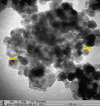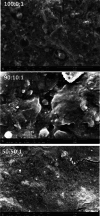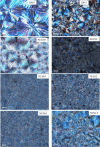Synergistic effect of TiO2 nanoparticles and poly (ethylene-co-vinyl acetate) on the morphology and crystallization behavior of polylactic acid
- PMID: 39103411
- PMCID: PMC11300595
- DOI: 10.1038/s41598-024-68023-4
Synergistic effect of TiO2 nanoparticles and poly (ethylene-co-vinyl acetate) on the morphology and crystallization behavior of polylactic acid
Abstract
The impact of adding ethylene vinyl acetate copolymer (EVA 80) and 1 wt% TiO2 nanoparticles on the morphology and crystallization behavior of poly(lactic acid) blends was investigated using DSC, SEM, and POM. Thermal analysis revealed the enhancement of crystallinity of PLA in the presence of TiO2 and higher EVA 80 content in the blend. The PLA and EVA 80 components showed compatibility, as evidenced by the shift of the glass transition temperatures of the PLA phase in the blend to lower values compared to neat PLA. The lower temperature shift of the cold crystallization of the PLA and the formation of the small spherulites of the PLA in the blends indicated that the EVA 80 and TiO2 act as a nucleating agent for crystallization. The non-isothermal crystallization parameters of the composites were evaluated using Avrami's modified model, the MO approach, and Friedman's isoconversional method. The Avrami's modified rate constant (K) and the effective activation energy values significantly increased with the incorporation of EVA 80 and TiO2 nanoparticles. Furthermore, the thermogravimetric analysis (TGA) showed improved thermal stability of PLA by adding EVA 80 and TiO2.
Keywords: DSC; Effective activation energy; MDSC; Modified Avrami; POM; Poly(ethylene-co-vinyl acetate); Polylactic acid (PLA); SEM; With vinyl acetate content 80 (EVA80).
© 2024. The Author(s).
Conflict of interest statement
The author declares no competing interests.
Figures













Similar articles
-
Property tuning of poly(lactic acid)/cellulose bio-composites through blending with modified ethylene-vinyl acetate copolymer.Carbohydr Polym. 2016 Feb 10;137:515-524. doi: 10.1016/j.carbpol.2015.10.094. Epub 2015 Nov 1. Carbohydr Polym. 2016. PMID: 26686158
-
Eco-friendly zinc-metal-organic framework as a nucleating agent for poly (lactic acid).Int J Biol Macromol. 2024 Jun;271(Pt 2):132691. doi: 10.1016/j.ijbiomac.2024.132691. Epub 2024 May 27. Int J Biol Macromol. 2024. PMID: 38810857
-
Modification of Processability and Shear-Induced Crystallization of Poly(lactic acid).Polymers (Basel). 2024 Dec 14;16(24):3487. doi: 10.3390/polym16243487. Polymers (Basel). 2024. PMID: 39771339 Free PMC article.
-
Effect of Nano Spinel Ferrites Co0.9Cu0.1Fe2O4 on Non-Isothermal Cold Crystallization Behaviours and Kinetics of Its Composites with Polylactic Acid.Polymers (Basel). 2024 Apr 24;16(9):1190. doi: 10.3390/polym16091190. Polymers (Basel). 2024. PMID: 38732659 Free PMC article.
-
An approach for compatibilization of the starch with poly(lactic acid) and ethylene-vinyl acetate-glycidyl-methacrylate.Int J Biol Macromol. 2020 Oct 15;161:44-58. doi: 10.1016/j.ijbiomac.2020.06.011. Epub 2020 Jun 5. Int J Biol Macromol. 2020. PMID: 32512092
Cited by
-
Impact of statistical poly(propylene co-ethylene) on the thermo-mechanical properties of high-density polyethylene.Sci Rep. 2024 Nov 8;14(1):27298. doi: 10.1038/s41598-024-77467-7. Sci Rep. 2024. PMID: 39516232 Free PMC article.
-
Morphology and thermal properties of poly(l-lactic acid) nucleated with 2,2'-(butane-1,4-diylbis(oxy))di(benzohydrazide).RSC Adv. 2025 Apr 28;15(17):13539-13551. doi: 10.1039/d5ra00368g. eCollection 2025 Apr 22. RSC Adv. 2025. PMID: 40296991 Free PMC article.
References
-
- El-Taweel, S. H. & Abboudi, M. Nonisothermal crystallization kinetics of PLA/nanosized YVO 4 composites as a novel nucleating agent. J. Appl. Polym. Sci.137, 48340. 10.1002/app.48340 (2020).10.1002/app.48340 - DOI
-
- Hamad, K., Kaseem, M., Ayyoob, M., Joo, J. & Deri, F. Polylactic acid blends. The future of green, light and tough. Prog. Polym. Sci.85, 83–127. 10.1016/j.progpolymsci.2018.07.001 (2018).10.1016/j.progpolymsci.2018.07.001 - DOI
LinkOut - more resources
Full Text Sources

